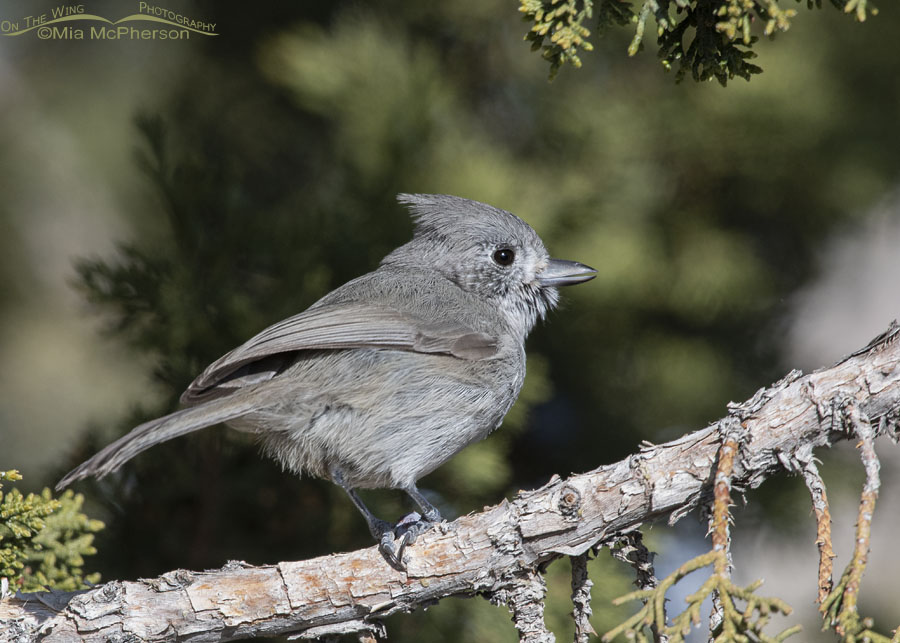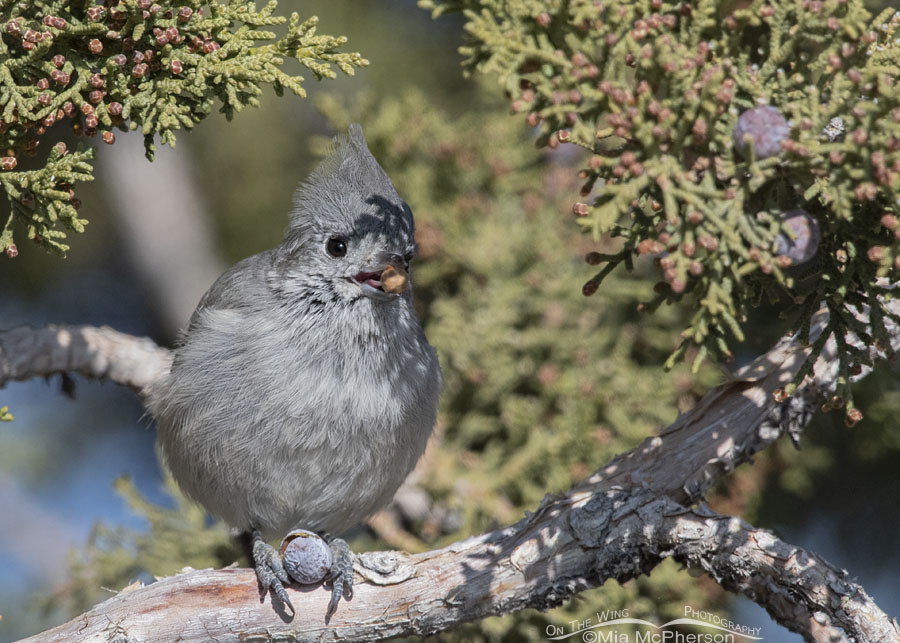 Juniper Titmouse in the West Desert – Nikon D500, f7.1, 1/1600, ISO 640, Nikkor 500mm VR with 1.4x TC, natural light
Juniper Titmouse in the West Desert – Nikon D500, f7.1, 1/1600, ISO 640, Nikkor 500mm VR with 1.4x TC, natural light
Because I have spent so much time out in the West Desert lately I have seen and heard quite a few Juniper Titmice moving through the junipers that dot the slopes of the mountains and foothills. I have tried hard but I just haven’t been able to get nice images of these birds when I have seen them. I thought I had taken one okay photo of a Juniper Titmouse on top of a juniper recently but after I got home and looked at it on my large screen I could tell it just wasn’t sharp enough to satisfy me or meet my standards.
These birds move fast, they don’t usually stay in one location long and they can be gone in less than the time it takes to blink an eye. What I have learned it that you have to get to where they are fast because if you muddle around and waste time trying to decide what to do they will be gone before you get to them.
I’d almost forgotten that I had taken images of a Juniper Titmouse foraging, cracking open a juniper berry and eating the seed out in the West Desert at the Simpson Springs campground almost two years ago. I think I need to get back out there soon or sit and wait patiently near the junipers that I have found them foraging in recently to get the photos I want of them. They are a semi-nemesis bird species for me, meaning that I have photos of them but still haven’t gotten the quality and quantity of them that I dream of.
I usually hear Juniper Titmice before I see them. I love hearing their calls and songs.
 Juniper Titmouse with a juniper seed – Nikon D500, f7.1, 1/3200, ISO 1250, Nikkor 500mm VR with 1.4x TC, natural light
Juniper Titmouse with a juniper seed – Nikon D500, f7.1, 1/3200, ISO 1250, Nikkor 500mm VR with 1.4x TC, natural light
I think the feeding behavior of Juniper Titmice is interesting to watch. First they find a juniper berry, fly to a branch, grasp the berry with their feet while using the branch as a solid base and then pound on it with their bills until it cracks open. Once the berry is open they use their bills to extract the seeds found inside.
I really wish the shadow of the juniper hadn’t been on the titmouse’s head in this photo. I’ve made a promise to myself to keep trying to get a photo of a feeding titmouse that is out in the open. I plan on keeping that promise.
By the way, juniper berries are actually round cones not berries but the name juniper berry has stuck and that is what most people call them.
And while I am on the subject of of names, I grew up saying “titmice” when referencing or speaking about more than one titmouse but wondered what was correct so I researched that subject the other day and found an answer on Birds and Blooms where Kenn and Kimberly Kaufman replied to that question:
“Kenn and Kimberly: The word titmouse doesn’t have any connection to the rodent. Instead, the second syllable is based on the Old English word mase, which means “small bird.” Technically, there’s no reason why mouse and mice should match titmouse and titmice. A purist would probably say titmouses is correct. On the other hand, a couple of major dictionaries (and bird guides) give titmice as plural. So you can probably get away with either!“
I’ll probably continue to use “titmice” when speaking about them but on my site I will try to use both.
Juniper Titmice might be considered drab or plain little birds but I think their beauty is subtle and that they are fascinating to observe and photograph.
Life is good.
Mia
Click here to see more of my Juniper Titmouse photos plus facts and information about this species.


The titmouses (awkward word as is “Killdeers,” and thank goodness I don’t have to say “gooses”) lived in a birdhouse in our back yard, along with Mountain Chickadees, Western Bluebirds and Ash-throated Flycatchers when we lived in the mountains of New Mexico. I was not into photography at that time, but tried to get photos of a titmouse during my several visits since then. Never had a “keeper.”
Nice photos…esp.the second…often, when I hear an unfamiliar bird, it turns out to be a Titmouse!
I just can’t get over how wonderfully you capture such exquisite detail in your images. These pics of the Titmouse are a case in point. I can practically count every feather. Beautiful. Thanks Mia.
Happy Thanksgiving.
Great photograph of the Desert Titmouse; showing it in its habitat provides greater appreciation for its coloration. So much information is included in the photograph of it opening the cone! Thank you!
Thank you for this subtle charmer – and huge thanks for the links to their call and song.